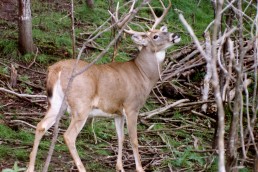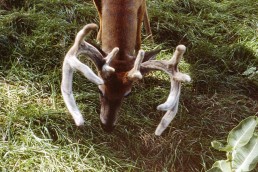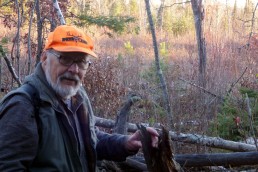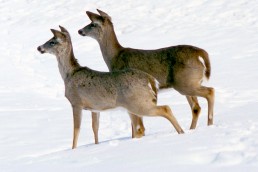How Human Scent Affects Hunted Whitetails part two
SHARE THIS POST
We whitetail hunters don’t fully realize many odors emitted continuously from our bodies even exist—unique odors from hair, breath and skin, and the hordes of bacteria that live on skin in the pores and sebaceous glands. Though our noses generally ignore these, they are present because whitetails don’t ignore them and react accordingly.
My own attempts to minimize odor have convinced me that anything I can do to at least minimize them is worthwhile when hunting. I wash my clothing with scent-free laundry soap and dry and air out my clothing and boots outside and under the roof of my porch for a week or more. I’ll also use soda instead of toothpaste to brush my teeth in deer camp, wash my skin—especially hands and underarms—with scentless soap, especially after cooking, never wear outer-hunting clothes while cooking food inside the big wall tent or when in restaurants, wear designated “camp clothing,” don fresh socks and underwear every morning, avoid overheating and perspiring while hiking, and more.
I do all these religiously because it’s proven whitetails downwind of my stand sites do in fact react with much less alarm, if any, if I take these precautions. I have also seen that whitetails can be greatly alarmed by hunters emitting strong odors made by hotcakes, sausages, pizza, fried onions, garlic, cooking meats, BBQ, tobacco smoke, tavern odors, gasoline or body odor. Upon getting a whiff of any of unusual strong odor, the older bucks or does may become so alarmed that they’ll even temporarily abandon their ranges, snorting repeatedly as they go.
Since the 1980s, deer hunters have been taught to believe one sure way to avoid being smelled by a whitetail is to hunt from an elevated treestand. I remember a photo published years ago that was intended to prove this, showing smoke streaming parallel to the ground from a treestand.
Think about this: Though wood smoke may course parallel to the ground or even straight up from a neighbor’s fireplace chimney, why then can you nonetheless always smell that familiar strong odor of burning wood at ground level downwind? It’s because odoriferous molecules from burning wood that you cannot see begin falling toward the ground the moment they emerge from the top of that chimney. Almost all invisible odoriferous molecules, characteristic of human deer hunters, do the same thing.
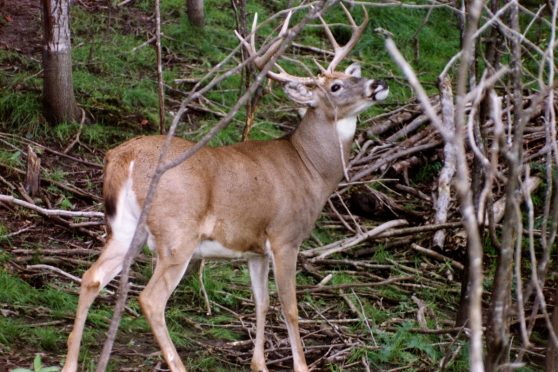
Back before 1970 when I began using primitive elevated platforms only 6 feet above the ground to study habits and behavior of whitetails and black bears, many deer passed so near I could have reached out and touched them. Amazingly, some fed only a few feet beneath my primitive platforms and many bedded within 10 yards to chew their cuds. Back then it certainly appeared that whitetails could not smell humans perched 6 or more feet above the ground.
Are you enjoying this post?
You can be among the first to get the latest info on where to go, what to use and how to use it!
A few years later, however, several black bears in my study area proved otherwise. While my son Dave was seated in one of our first permanent treestands overlooking his bear bait, a moderately sized bear climbed to his platform and reached for the half-empty jar of honey located directly beneath his seat—we use honey as a “positioning bait” next to our bait cribs. This act proved black bears can smell food, and hunters as well, perched 9 feet or more above the ground. This was a hunt-changing discovery. Thereafter, several other bears proved they too could smell foods in trees, climbing to mesh bags containing bacon as high as 55 feet above the ground.
Knowing that a whitetail’s nose is as keen as a black bear’s nose, if not more so, it was then logical to assume deer can also smell hunters perched up in the trees. Being accustomed to being hunted by creatures at ground level only back in the 1970s, it didn’t occur to them to look upward into the trees for anything dangerous upon suddenly smelling the human odors drifting downward. Following a brief look-around, they acted as if they had concluded that they only smelled the trail scents made by a hunter that had passed through the area earlier. Upon deliberately attracting the attention of some deer by raising and waving our hands in treestands back then (a one-day experiment), all whitetails reacted exactly like all whitetails react today: abandoning the area quickly and noisily or stealthily and silently.
By the year 2000, close-range sightings of unsuspecting mature whitetails (especially older bucks) near treestands had dropped to a small percentage of sightings during the previous decade. Today, mature whitetails on the move everywhere routinely search ahead for motions and dark, sky-lighted silhouettes of hunters in trees. And while downwind, they are routinely alerted by our invisible odoriferous molecules settling toward the ground.
Upon reaching the ground, odors of treestand hunters do not soon disappear; they continuously spread vertically and horizontally throughout a triangular-shaped area that covers the ground up to 200 yards wide, and 200 yards downwind. A whitetail may approach a treestand from crosswind or while quartering into the wind without smelling a stand-hunter in a tree (or on the ground) and the inexperienced fawns or yearlings sometimes completely ignore human odors altogether while approaching from directly downwind. Nonetheless, being positioned at a greater height in a treestand protects no hunter from being smelled and subsequently avoided by mature downwind whitetails these days.
Only by approaching a stand site from downwind or crosswind, and then stand-hunting downwind or crosswind of where an intended quarry is expected to appear, can a stand-hunter be absolutely certain he or she cannot be smelled, identified and subsequently avoided by that deer.
MWO
SHARE THIS POST
Did you enjoy this post?
You can be among the first to get the latest info on where to go, what to use and how to use it!
Dr. Ken Nordberg
Based on his 55 years of field research, Dr. Ken Nordberg has written more than 800 magazine articles, 12 books on whitetails—including the famous Whitetail Hunter’s Almanac series—five books on black bear hunting and produced Buck and Bear Hunting School videos. You may peruse his encyclopedic website with whitetail hunting tips: drnordbergondeerhunting.com, his blog: drnordbergondeerhunting.wordpress.com, or social media pages.
